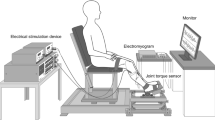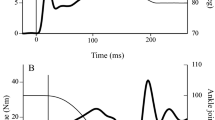Abstract
Rotation of an upper limb joint produces excitatory stretch reflex peaks M1 and M2 in the stretched muscles and simultaneous decrease in electromyographic (EMG) activity in the shortened muscles. The objective of this study was to examine whether the decreased activity in the antagonists (rINHIB) is purely from unloading of the spindles or receives active inhibition involving inhibitory interneurons. If rINHIB is due only to unloading, then the termination of rINHIB should vary with the duration of perturbation used to elicit stretch reflex, namely shorter stretches should result in shorter values of decreased periods of EMG. To examine this question, rectangular pulses, ranging in duration from 25 to 150 ms, were used to stretch wrist flexors or extensors with a torque motor. These rectangular pulses resulted in joint rotations which peaked at times (T peak) ranging from approximately 75–160 ms. As shown by previous authors, when the duration of rotation was shortened, the magnitude of M1 did not change, while the magnitude of M2 decreased. However, termination time of rINHIB in the shortened muscles did not change with change in T peak, implying thereby that unloading of spindles of the antagonist muscles is not the only mechanism for the reduction in activity and that inhibitory reflex pathways most likely contribute. Possible sources of inhibition are discussed for the short- and long-latency inhibition.






Similar content being viewed by others
References
Al-Falahe NA, Nagaoka M, Vallbo AB (1990) Response profiles of human muscle afferents during active finger movements. Brain 113:325–346
Al-Falahe NA, Nagaoka M, Vallbo AB (1991) Dual response from human muscle spindles in fast voluntary movements. Acta Physiol Scan 141:363–371
Angel RW (1987) Unloading reflex of a hand muscle. Electromyogr Clin Neurophysiol 67:447–451
Angel RW, Weinrich M (1986) Stretch and unloading reflexes in a human hand muscle. Exp Neurol 94:348–358
Angel RW, Garland H, Moore W (1973) Unloading reflex during blockade of antagonist muscle nerves. Electromyogr Clin Neurophysiol 34:303–307
Aymard C, Chia L, Katz R, Lafitte C, Pénicaud A (1995) Reciprocal inhibition between wrist flexors and extensors in man: a new set of interneurons? J Physiol 487:221–235
Baldissera F, Cavallari O, Fournier E, Pierrot-Deseilligny E, Shindo M (1987) Evidence for mutual inhibition of opposite Ia interneurones in the human upper limb. Exp Brain Res 66:106–114
Brinkman RSA, Türker KS (2003) A method for quantifying reflex responses from intra-muscular and surface electromyogram. J Neurosci Methods 122:179–193
Calancie B, Bawa P (1985) Firing patterns of human flexor carpi radialis motor units during the stretch reflex. J Neurophysiol 53:1179–1193
Cavallari P, Fournier E, Katz E, Pierrot-Deseilligny E, Shindo M (1984) Changes in reciprocal inhibition from wrist extensors to wrist flexors during voluntary movement in man. Exp Brain Res 56:574–576
Cheney PD, Fetz EE (1984) Corticomotoneuronal cells contribute to long-latency stretch reflexes in the rhesus monkey. J Physiol 349:249–272
Colburn TR, Evarts EV (1978) Use of brushless DC torque motors in studies of neuromuscular function. In: Desmedt JE (ed) Cerebral motor control in man: long loop mechanisms. Prog Clin Neurophysiol, vol 4. Karger, Basel, pp 153–166
Conrad B, Meyer-Lohmann J, Matsunami K, Brooks VB (1975) Precentral unit activity following torque pulse injections into elbow movements. Brain Res 94:219–236
Day BL, Rothwell JC, Marsden CD (1983) Transmission in the spinal reciprocal Ia inhibitory pathway preceding willed movements of the human wrist. Neurosci Lett 37:245–250
Day BL, Marsden CD, Obeso JA, Rothwell JC (1984) Reciprocal inhibition between the muscles of the human forearm. J Physiol 349:519–534
Ellaway PH (1978) Cumulative sum technique and its application to the analysis of peristimulus time histograms. EEG Clin Neurophysiol 45:302–304
Evarts EV, Tanji J (1976) Reflex and intended responses in motor cortex pyramidal tract neurons of monkey. J Neurophysiol 39:1069–1080
Fetz EE, Cheney PD (1987) Functional relations between primate motor cortex cells and muscles: fixed and flexible. Ciba Found Symp 132:98–112
Gielen CC, Ramaekers L, van Zuylen EJ (1988) Long-latency stretch reflexes as co-ordinated functional responses in man. J Physiol 407:275–292
Grey MJ, Mazzaro N, Nielsen JB, Sinkjær T (2004) Ankle extensor proprioceptors contribute to the enhancement of the soleus EMG during the stance phase of human walking. Can J Physiol Pharmacol 82:610–616
Hufschmidt H-J (1966) The demonstration of autogenic inhibition and its significance in human voluntary movement. In: Granit R (ed) Muscular afferents and motor control. Wiley, New York, pp 269–274
Hultborn H (2006) Spinal reflexes, mechanisms and concepts: from Eccles to Lundberg and beyond. Prog Neurobiol 78:215–232
Hultborn H, Illert M, Santini M III (1976) Convergence on interneurones mediating the reciprocal Ia inhibition of motoneurons. Acta Physiol Scan 96:193–201
Humphrey DR, Reed D (1983) Separate cortical systems for control of joint movement and joint stiffness: reciprocal activation and coactivation of antagonist muscles. In: Desmedt JE (ed) Motor control mechanisms in health and disease. Raven press, NY, pp 347–372
Jankowska E, Robert WJ (1972) Synaptic actions of single interneurons mediating reciprocal Ia inhibition of motoneurons. J Physiol 222:623–642
Kurtzer I, Pruszynski A, Scott SH (2010) Long-latency and voluntary responses to an arm displacement can be rapidly attenuated by perturbation offset. J Neurophysiol 103:3195–3204
Lacquaniti F, Soechting JF (1986) EMG responses to load perturbations of the upper limb: effect of dynamic coupling between shoulder and elbow motion. Exp Brain Res 61:482–496
Lee RG, Tatton WG (1982) Long latency reflexes to imposed displacements of the human wrist: dependence on duration of movement. Exp Brain Res 45:207–216
Lee RG, Murphy JT, Tatton WG (1983) Long-latency myotatic reflexes in man: mechanisms, functional significance, and changes in patients with Parkinson’s disease or hemiplegia. In: Desmedt JE (ed) Motor control mechanisms in health and disease, Raven Press, New York, pp 489–508
Lemon RN, Porter R (1976) Afferent input to movement-related precentral neurones in conscious monkeys. Proc R Soc Lon B 194:313–339
Lewis GN, Perreault EJ, MacKinnon CD (2005) The influence of perturbation duration and velocity on the long-latency response to stretch in the biceps muscle. Exp Brain Res 163:361–369
Lewis GN, MacKinnon CD, Trumbower R, Perreault EJ (2010) Co-contraction modifies the stretch reflex elicited in muscles shortened by a joint perturbation. Exp Brain Res 207:39–48
Manning CD, Bawa P (2011) Heteronymous reflex connections in human upper limb muscles in response to stretch of forearm muscles. J Neurophysiol 106:1489–1499
Manning CD, Tolhurst SA, Bawa P (2012) Proprioceptive reaction times and long latency reflexes in humans. Exp Brain Res 221:155–166
Marsden CD, Merton PA, Morton HB, Adam J (1977) The effect of lesions of the sensorimotor cortex and the capsular pathways on servo responses from the human long thumb flexor. Brain 100:503–526
Matthews BHC (1931) The response of a muscle spindle during active contraction of a muscle. J Physiol 72:153–174
Matthews PBC (1972) Mammalian muscle receptors and their central actions. Arnold, London
Matthews PBC (1991) The human stretch reflex and the motor cortex. Trends Neurosci 14:87–91
Matthews PBC, Miles TS (1988) On the long-latency reflex responses of the human flexor digitorum profundus. J Physiol 404:515–534
Miscio G, Pisano F, Del Conte C, Pianca D, Colombo R, Schieppati M (2001) The shortening reaction of forearm muscles: the influence of central set. Clin Neurophysiol 112:884–894
Nakashima K, Rothwell JC, Day BL, Thompson PD, Shannon K, Marsden CD (1989) Reciprocal inhibition between forearm muscles in patients with writer’s cramp and other occupational cramps, symptomatic hemidystonia and hemiparesis due to stroke. Brain 112:681–697
Nielsen JB, Crone C, Hultborn H (2007) The spinal pathophysiology of spasticity—from a basic science point of view. Acta Physiol 189:171–180
Perlmutter S, Maier M, Fetz EE (1998) Activity and output linkages of spinal premotor interneurons during voluntary wrist movements in the monkey. J Neurophysiol 80:2475–2494
Perreault EJ, Chen K, Trumbower RD, Lewis G (2008) Interaction with compliant loads alter stretch reflex gains but not intermuscular coordination. J Neurophysiol 99:2101–2113
Pierrot-Deseilligny E, Mazevet D (2000) The monosynaptic reflex: a tool to investigate motor control in humans. Interest and limits. Neurophysiol Clin 30:67–80
Rossi A, Decchi B, Zalaffi A, Mazzocchio R (1995) Group Ia non-reciprocal inhibition from wrist extensor to flexor motoneurons in humans. Neurosci Lett 191:205–207
Rothwell JC (1990) Long latency reflexes of human arm muscles in health and disease. In: Rossini PM, Mauguière F (eds) New trends and advanced techniques in clinical neurophysiology (EEG Suppl 41). Elsevier, Amsterdam, pp 251–263
Rothwell JC, Day BL, Obeso JA, Berardelli A, Marsden CD (1988) Reciprocal inhibition between muscles of the human forearm in normal and in patients with idiopathic torsion dystonia. Adv Neurol 50:133–140
Seochting JF, Lacquaniti F (1988) Quantitative evaluation of the electromyographic responses to multidirectional load perturbations of the human arm. J Neurophysiol 59:1296–1313
Sherrington CS (1892) Note on the knee-jerk and the correlation of action of antagonistic muscles. Proc R Soc Lond B 52:556–564
Sherrington CS (1893) Further experimental note on the correlation of action of antagonistic muscles. Proc R Soc Lond B 53:407–420
Sherrington CS (1896) On reciprocal innervations of antagonistic muscles. Third note. Proc R Soc Lond B 60:414–417
Sinkjær T, Anderson JB, Ladouceur M, Christensen LOD, Nielson JB (2000) Major role for sensory feedback in soleus EMG activity in the stance phase of walking in man. J Physiol 523:817–827
Stein RB (1974) Peripheral control of movement. Physiol Rev 54:215–243
Tanaka R (1974) Reciprocal inhibition during voluntary movement in man. Exp Brain Res 21:529–540
Tatton WG, Lee RG (1975) Evidence for abnormal long-loop reflexes in rigid Parkinsonian patients. Brain Res 100:671–676
Tatton WG, Bawa P, Bruce IC (1979) Altered motor cortical activity in extrapyramidal rigidity. In: Poirier LJ, Sourkes TL, Bedard PJ (eds) Advances in neurology, vol 24. Raven Press, NY, pp 141–160
Thilmann AF, Schwarz M, Topper R, Fellows SJ, Noth J (1991) Different mechanisms underlie the long latency stretch reflex response of active human muscle at different joints. J Physiol 444:631–643
Towles JD, Kamper DG, Rymer WZ (2010) Lack of hypertonia in thumb muscles after stroke. J Neurophysiol 104:2139–2146
Vallbo AB (1970) Slowly adapting muscle receptors in man. Acta Physiol Scan 78:315–333
Valls-Solé J, Hallett M (1995) Modulation of electromyograhic activity of wrist flexor and extensor muscles in patients with writer’s cramp. Mov Disord 10:741–748
Acknowledgments
Authors thank Professor R Chua for his help with the manuscript. This work was supported by a grant from Natural Science and Engineering Research Council of Canada.
Author information
Authors and Affiliations
Corresponding author
Rights and permissions
About this article
Cite this article
Manning, C.D., McDonald, P.L.L., Murnaghan, C.D. et al. Reciprocal inhibition versus unloading response during stretch reflex in humans. Exp Brain Res 226, 33–43 (2013). https://doi.org/10.1007/s00221-013-3408-5
Received:
Accepted:
Published:
Issue Date:
DOI: https://doi.org/10.1007/s00221-013-3408-5




